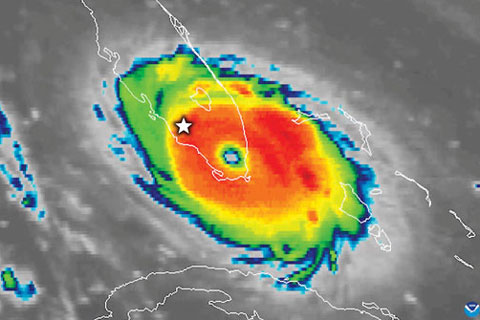7/1/2024
The Hurricane & the Fungi
Chris Beytes

It’s been long known that mycorrhizae offer a beneficial symbiotic relationship with plants. The word comes from Greek, where “myco” means fungus and “rhiza” means root. In this relationship, the fungus colonizes the roots of the plant, forming a network that extends the plant’s root system. This association benefits both the fungus and the plant—the fungus receives nutrients from the plant, while the plant gains increased access to water and nutrients in the soil due to the fungal network’s extended reach. It’s said that mycorrhizae can increase the absorption area for water and nutrients by up to 100 times.
Pictured: Hurricane Andrew as it crossed Florida. Immokalee is the white star.
By the early 1980s, there was much interest in mycorrhizae among the research community, including among researchers inside Canadian peat company Premier Tech. So, in 1983, they opened the Premier Tech Research Center with the initial goal of studying mycorrhizae to explore its potential in horticulture and agriculture. By 1987, they were looking for strains of the fungi with commercial potential, and by 1989, they were just beginning to add it to potting mixes and test it with greenhouse customers. But another area of agriculture was awaiting them: field-grown vegetables.
Enter Ed Bloodnick, now Director of Grower Services for Premier Tech. Ed joined the company in 1987, in part to help look for ways to commercialize this new technology and get proof of its performance. Field-grown tomatoes and peppers are enormously important North American crops, so Ed decided to partner with top mycorrhizae researchers at the USDA and the University of Florida to test the fungi in the field, to see if it protected plants in any way from disease (tomatoes, for instance, are susceptible to Fusarium) and if it provided better yield.
The most suitable place to do that is Immokalee in Southwest Florida, in the heart of winter vegetable production country. In the spring of 1992, Premier Tech and the researchers contracted with Johnny Johnson Greenhouse & Nursery to grow 100,000 tomato and 120,000 pepper transplants in mycorrhizal-inoculated growing medium, and the same number of seedlings in non-inoculated growing medium as a control. They were then planted out in fumigated fields, 4,800 to 5,000 tomatoes per acre, 18,000 to 20,000 peppers per acre—more than 50 acres of trials.
After planting, the researchers were monitoring and testing weekly through the summer, “then it’s the third week of August and we see something coming across the Atlantic Ocean, heading right for South Florida,” Ed said.
That something was Hurricane Andrew, soon to be the most damaging hurricane to ever hit the U.S. (until Hurricane Katrina in 2005). At 5:00 a.m. on August 24, the Category 5 hurricane made landfall at Homestead, two hours southwest of Immokalee, with 166-mph winds. It had subsided only slightly in strength by the time it’d crossed the state four hours later. The eye passed south of Immokalee, but the more powerful “dirty” edge of the storm scored a direct hit, wiping out everything, tomatoes and peppers included.
Ed followed the track of Andrew from his home in Pennsylvania.
“I was watching the news as the storm approached … crossing my fingers, hoping that it was going to track differently. Unfortunately, it travelled in the direct path across Florida … I had some experience before with this, and when I saw that it was going to be above a category 3, forget it. It was heading right across, and the top edge of it was hitting Immokalee, and I knew that was going to be it.”
He called it “disheartening” because he really wanted to prove the benefits of mycorrhizae to the vegetable farming community.
Thankfully, while this was their biggest and most important vegetable trial in 1992, it wasn’t their only one—they also had trials going in New Jersey and Quebec, where results were positive, with yield improved by as much as 21% and fruit grades improved, too.
“This made a big difference for the farmers,” Ed said. “Because they really did nothing other than grow the transplants in the growing medium media with the mycorrhizae, then transplant the inoculated seedlings into the field six to eight weeks later.”
And it doesn’t take much— maybe four 3.8 cubic-ft. bales of mix for an acre’s worth of transplants.
Regrouping and renewing their research relationship, Ed, the USDA and University of Florida went back to Immokalee the next year, planted a new trial, and this time got the hoped-for data on disease resistance, finding that the inoculated plants had less incidence of Fusarium and better stands on the plants and better yield, research that was published by the academics involved. Vegetable growers began adopting the use of the beneficial fungi—not just in Florida—but across North America.
Hurricane Andrew may have put a dent in their early research efforts, but it didn’t affect the end result. Since then, Premier Tech has greatly improved the production of mycorrhizae, going to an aseptic system that ensures purity and consistency. And they know much more about how to incorporate it into potting mixes. From mycorrhizae, they’ve added another biological active ingredient, Bacillus, to their PRO-MIX line under the AGTIV brand. And they also offer the bacteria rhizobium and the fungi Serendipita to the agriculture market.
Says Ed today, as he advises growers on utilizing the technology, “It was all a great learning experience about refining the product and bringing a new solution to growers.” GT